Designing a cohesive outdoor space involves more than just placing a few plants and furniture pieces in your garden. A truly unified garden harmonizes design elements, creating an inviting and functional area where all aspects—colors, textures, furniture, and plants—work together seamlessly. Whether you’re designing a backyard, a patio, or a small balcony, the goal is to ensure that each element feels interconnected and contributes to the overall aesthetic. Here are some tips for creating a cohesive outdoor space.
Establish a Clear Plan
Before you start planting or purchasing furniture, it’s important to map out your space. Consider the size and shape of your garden or patio and how you want to use it. Do you want an area for dining, relaxation, or gardening? Understanding the flow of your space will help you determine where different elements should go. Create zones within your garden that serve different functions—such as a seating area, a garden plot, or a pathway—and make sure there’s a natural flow between them. Planning your layout ahead of time ensures that every part of your space has a purpose and complements the others.
Choose a Unified Color Palette
Color is one of the most effective tools for creating a cohesive outdoor space. Choose a color palette that reflects the atmosphere you want to create. For example, calming neutral tones, such as greens, browns, and whites, can make a space feel serene and natural, while bright colors can inject energy and vibrancy into the environment. Stick to your chosen color scheme throughout the design, from plants and flowers to furniture and outdoor accessories. Using a consistent palette helps tie everything together visually, making the entire space feel intentional and well-organized.
Balance Hardscaping and Softscaping
Creating a balance between hardscaping (the non-plant elements like patios, pathways, and walls) and softscaping (plants, flowers, trees) is key to a cohesive outdoor space. Hardscaping elements provide structure and define the layout, while softscaping adds life, color, and texture. Ensure that neither element overpowers the other. For example, a stone patio can anchor the space, while surrounding it with lush greenery and flowering plants adds softness and vibrancy. When selecting materials for hardscaping, make sure they complement your plant choices in color and texture to avoid clashes.
Incorporate Focal Points
Focal points are essential in garden design as they draw attention and create a sense of purpose. A focal point could be anything from a beautifully sculpted tree to a water feature or a striking piece of outdoor art. Focal points help guide the eye and establish a sense of structure in the space. Choose one or two focal points for your garden and arrange your furniture and plantings around them. This can make your garden feel well-planned and visually appealing.
Mix Textures for Interest
Texture is another important consideration in creating a cohesive outdoor space. By combining different textures, you can add depth and interest to your garden. For example, pair the smoothness of stone with the softness of grass or the roughness of wood with delicate, feathery plants. Mixing various textures keeps the space from feeling flat and ensures that there is always something interesting to look at or touch. Layering textures throughout the space, from the surface of the patio to the leaves of your plants, helps maintain a dynamic yet cohesive atmosphere.

Plan for Seasonal Changes
A well-designed outdoor space should look beautiful throughout the year. When selecting plants, consider incorporating a mix of evergreens, flowering plants, and seasonal elements that offer something different in each season. For instance, in the spring, your garden might feature blooming flowers, while in the fall, colorful foliage and decorative pumpkins can provide seasonal interest. Including plants that provide year-round appeal ensures that your outdoor space remains inviting regardless of the season, keeping the space fresh and relevant all year long.






